Performance Retrospective: AMD’s Radeon HD 7970M
by Jarred Walton on June 21, 2013 5:25 PM ESTMainstream/High 1600x900 Gaming Performance
Moving up to our “Mainstream” gaming tests (high detail, no 4xAA, 1600x900 resolution), there’s a lot more demanded of the GPU this time around, so CPU and platform limitations aren’t likely to be as large of a factor. Integrated graphics solutions (outside of perhaps Intel’s Iris Pro Graphics) are also going to prove insufficient for our test suite in nearly all of these games. Let’s look at round two of the 7970M performance.
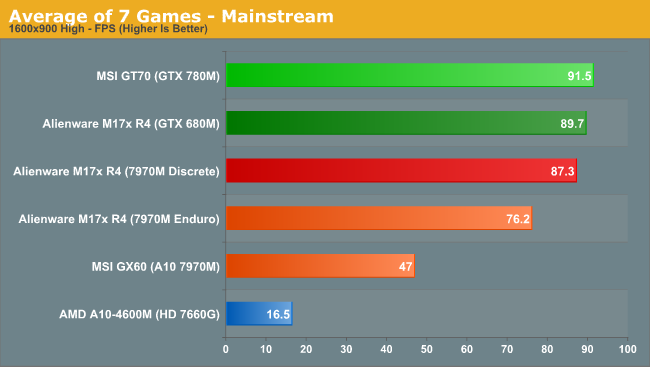
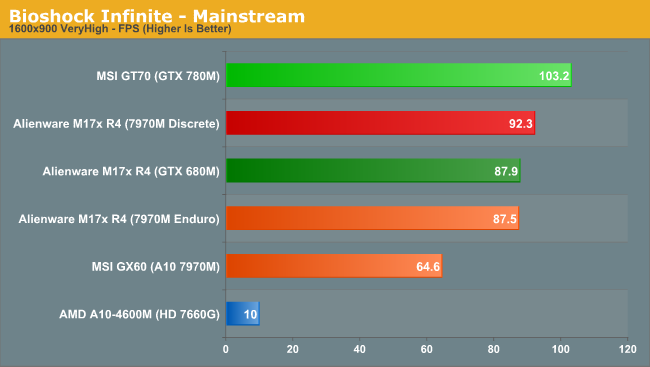
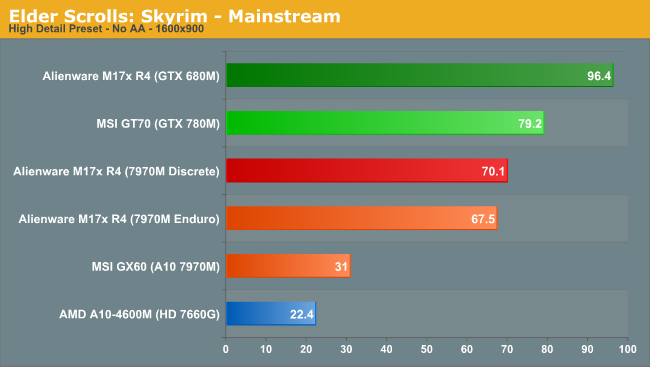
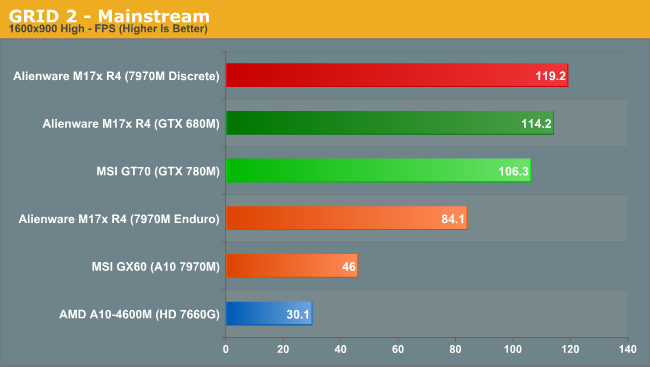



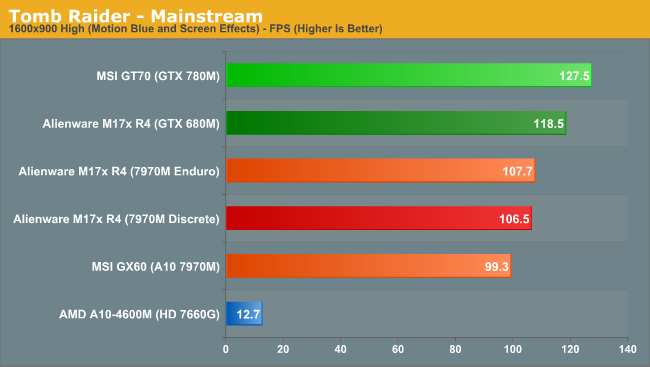
Despite the increase in graphics complexity, at least on the Alienware M17x R4 the use of Enduro is still bringing a performance penalty in some titles. On average, switching to discrete mode improves performance by 14%, slightly less than we saw with our Value settings; however, the individual games show varying amounts of separation. Bioshock is now nearly the same, with only a 5% performance increase, and in fact most of the games show less than a 5% increase by using discrete mode (though again it’s worth mentioning the rendering errors on DX9 titles with the 13.6 beta drivers). The two titles that show a significant performance increase by using discrete mode are GRID 2 (42%) and Sleeping Dogs (46%); interestingly, Tomb Raider is actually slightly faster with Enduro at these settings, though the 1% difference is within the margin of error.
The Intel Enduro vs. AMD Enduro results are much closer this round, though Intel still holds a commanding lead. No longer is the Core i7 offering twice the frame rates in most games; at 900p High it’s “only” 62% faster on average—but that’s mostly due to the closer performance in two of the seven games. Skyrim, Sleeping Dogs, and StarCraft II are still the big losers, with more than twice the performance on Intel’s CPU, but GRID 2 and Metro are nearly as bad at 83% and 91% performance improvements, respectively. In fact, of those five titles, Skyrim and Sleeping Dogs flirt with the 30FPS “playable” boundary, and Metro and StarCraft II actually fall below 30FPS. Getting to the last two games, Bioshock isn’t too bad, showing a mere 35% performance increase, and Tomb Raider is the one exception where platform doesn’t make much of a difference. Tomb Raider has proven to be almost wholly dependent on GPU performance, and the advantage for the Intel platform is an insignificant 8%. At our Mainstream presets, the 7970M also proves much faster than the 7660G, as it should; this time, it’s nearly three times as fast.
Finally, the NVIDIA vs. 7970M matchup continues to be quite close on average. The GTX 680M leads by 3% overall, with the only significant lead coming in Skyrim (38%); the 680M also claims smaller (<10%) leads in StarCraft II and Tomb Raider (that last one being an AMD title). Meanwhile, the 7970M holds small leads in Bioshock, GRID 2, Metro: Last Light (an NVIDIA title, so turnabout is fair play), and Sleeping Dogs. The 780M continues to be hamstrung by CPU throttling in the GT70, and we hope to have a new test notebook shortly to see what the 780M can really do when it’s allowed to stretch its legs. For now, the lead over the 7970M is 5% on average, with a smaller lead in Skyrim and only two small losses (GRID 2 and Sleeping Dogs).










58 Comments
View All Comments
Aegrum - Friday, June 21, 2013 - link
Great article - I'm really happy to see some benches from these behemoth systems.I will say, though, comparing a $150 APU to a $400 CPU isn't exactly a fair assessment. I'd rather see the GX60 compared to a system in its price range, something with a GTX770m or GTX765m on board, like an MSI GE60 or Sager NP8230.
JarredWalton - Friday, June 21, 2013 - link
See concluding comments on pricing. I know it's not "fair", but however you slice it the MSI GX60 isn't delivering on all fronts as a gaming notebook -- unless games like StarCraft II and Skyrim simply don't matter?Samus - Saturday, June 22, 2013 - link
AMD driver issues? Shocking.huaxshin - Saturday, June 22, 2013 - link
Try to be more precise Jarred:Its not the notebook that isn`t delivering, its the 4600M APU.
JarredWalton - Saturday, June 22, 2013 - link
Let's see...MSI has performance issues on their Dragon laptop. This AMD system is also from MSI. Could there be a correlation? I would say yes. Trinity isn't blazing fast by any means, but in single-threaded performance it's usually no worse than half the speed of single-threaded Core i7. We're seeing cases where it's much less than that, which suggests drivers, platform, and/or laptop are also a factor. My guess is Enduro requires more CPU performance than discrete-only, and it would potentially dirty some of the cache thus making misses more common and thus reducing performance more on some platforms than others.huaxshin - Saturday, June 22, 2013 - link
Dragon Edition 2 review: Cooling problems > hot temperatures > throttling > CPU performance go down > CPU bottleneck > GPU performance go down > Poor gaming performanceGX60: Good cooling
/end
GX60 saw NO CPU throttling nor high temperatures. Since the high end GPUs require a high end CPU, and A10-4600M score half of the 3610QM in single and 1/4th in Multi Cinebench, you don`t have to be a genious to understand that the APU is just too weak. Heck, even look at the lowest end i5, 3210M and its over 50% better in Multi.
I have seen what you guys are trying to do. You are trying to blame MSI for it. Like they can control the very poor APU performance. They are the only OEM that pair up the high end GPU with AMD APU. The notebook is pretty cheap, but its a gamble: it can outrun the GTX 660M in some games, while its the other way around in other.
Dustin Sklavos - Saturday, June 22, 2013 - link
Are you seriously still here?huaxshin - Saturday, June 22, 2013 - link
Yes because you two cannot answer critique and I am able to see right through your recent reviews.Since the PSU is 180W, the cooling is way overbuilt for the APU since it is the exact same design that house hotter Intel CPUs, I am looking for an answer from one of you two about what caused the 7970M performance in the GX60 to go down when it is not the APU itself.
Jarred blame MSI, which is laughable, since all MSI does is include support through BIOS, make sure the cooling is efficient and make sure the components get all the power.
Drivers? AMD make them
Platform? AMD
Laptop? Please enlight us what exactly is wrong with the laptop. I think I covered pretty much everything
Enduro? Perhaps it can count for -some- of the performance decrease. But not 50% decrease or whatever it is. Once again you two cannot look past the fact that the i7 with 7970M and Enduro does far better than 4600M and 7970M with Enduro. That means, the APU is weak...
JarredWalton - Saturday, June 22, 2013 - link
"They are the only OEM that pair [sic] up the high end GPU with AMD APU." Exactly. Why do you think that is? If MSI is selling a laptop which performs far worse than most would expect, that is their problem. If Dell were to make a notebook and stick in an Atom CPU with a high-end GPU, it's not Intel's fault that Dell made a bad design decision.It's nice of MSI to try selling a less expensive gaming laptop, but they should know as well as anyone whether the APU is sufficient to handle the task at hand. And yet, they started shipping the GX60 and now there's an updated version. I blame AMD plenty for their drivers, but MSI does not get off scott free for creating the design in the first place, especially if it doesn't work well.
I am going to see about simulating performance of the 7970M and A10-4600M on the desktop side, using a 7870 and A10-5800K and then underclocking both to the same level as the MSI GX60 is running at. That will remove Enduro from the equation in the process, and I can almost guarantee that performance will be far better than what we're seeing on the GX60. However, that doesn't mean it's only Enduro -- look at the M17x and how the Enduro penalty tapers off at higher resolutions and settings. That's not happening with GX60. And even under gaming loads the CPU cores are at less than 75%, so there's a whole core sitting idle somewhere.
Is it really just a case of the APU and Enduro using so much CPU computational power than performance falls flat, or is it something else like issues with the firmware and BIOS coming into play? The latest BIOS from MSI for the GX60 improved performance by as much as 10%, so there could be a lot of room left for improvement. Even if the problem is completely with AMD's APU performance, again, go back to point number one: if you sell a system that has a poorly matched CPU and GPU, it is your fault as the system manufacturer, because you put the two together.
As for you and your fanboy rantings, you're not helping anything here. Your comments on the NVIDIA GTX 780M article were worthless, as you tried to absolve both NVIDIA and MSI from responsibility. Well, NVIDIA isn't to blame for MSI's bad QA, certainly. And if it's just a bad sample from MSI, sent to a review site that gets major traffic? Shame on MSI yet again. I actually have an MSI GE40 that's mostly good and doesn't have any real issues other than an outdated industrial design and a crappy LCD, which means yet again that it misses the mark. Who do I blame next time, the LCD manufacturer for daring to sell a low contrast LCD?
vlad42 - Sunday, June 23, 2013 - link
Hey Jarred,I was actual going to recommend simulating the A10-4600m and HD 7970m in discrete mode, but I get you beat me to it.
Also, I would recommend contacting AMD’s driver team and share these results with them. It is quite possible that they are unaware of the performance issues that the HD 7970m has in Enduro mode on sub-1080p resolutions (similar to how they were unaware of the micro stuttering issues with their cards). If you think about it, AMD might simply be assuming that any laptop that would have an HD 7970m would also have at least a 1080p display. Thus, they might only be testing Enduro’s performance at 1080p, which, incidentally, is where you found that the performance difference between Enduro and discrete modes on the Alienware M17x R4 was only about 3%.
You might even want to suggest fixing the Enduro performance problems because the ultra high resolution laptops/displays that are coming out, such as Samsung’s ATIV Book 9 with 3200x1800 display, will likely cause gamers to run games at ¼ the native resolution of the display (in the case of the ATIV Book 9 that would be 1600x900) due to how hard it is for any desktop gpu to drive these kinds of resolutions. While you are in contact with them (assuming you do contact them of course) you could try to get an update regarding the DX 9 rendering fix.